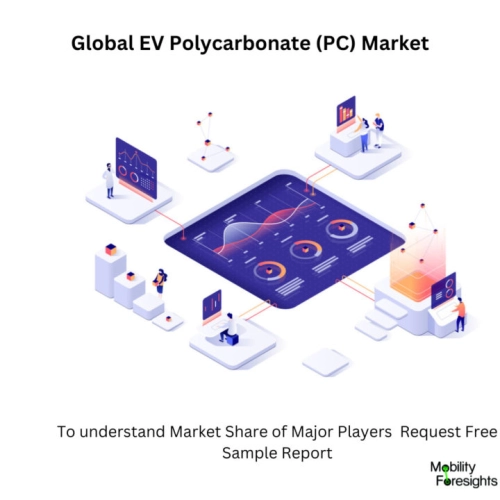
- Get in Touch with Us

Last Updated: Apr 25, 2025 | Study Period: 2023-2030
A class of thermoplastic polymers known as polycarbonates (PC) have carbonate groups in their chemical compositions. Engineering uses polycarbonates because they are durable, robust materials that come in some grades that are optically clear.
They may be thermoformed, moulded, and worked with ease. Polycarbonates have a wide range of uses as a result of these qualities. Polycarbonates are included on the RIC list as "Other" because they lack a distinctive resin identification number (RIC).
The precursor monomer bisphenol A may be present in polycarbonate products (BPA). Polycarbonate is a strong substance. It has a low scratch resistance despite having a good impact resistance. Therefore, polycarbonate eyewear lenses and polycarbonate external automotive components are given a strong coating.
Polymethyl methacrylate (PMMA, acrylic) and polycarbonate have similar properties, although polycarbonate is tougher and more resistant to high temperatures.
Amorphous, naturally transparent polycarbonate plastics are known as PCs. The raw material allows for the internal transmission of light virtually in the same capacity as glass, despite being made commercially available in a variety of hues (some translucent, others not).
When impact resistance and/or transparency are required for a product, polycarbonate polymers are particularly helpful in the production of a number of materials.
Plastic lenses for spectacles, medical devices, automobile components, protective equipment, greenhouses, digital disks, and outdoor lighting fixtures are frequently made of PC.
Additionally, polycarbonate has excellent heat resistance and can be blended with materials that are flame resistant without significantly degrading the material. Engineering plastics, like polycarbonate, are utilised for stronger, more capable materials, like impact-resistant "glass-like" surfaces.
The flexibility of polycarbonate is another quality. Similar to aluminium sheet metal, it can normally be produced at room temperature without cracking or breaking.
Even tiny angle bends are achievable without heat, however deformation may be easier with it. Because of this quality, polycarbonate sheet stock is very helpful for prototyping applications where sheet metal is not a viable option.
Additionally, polycarbonate is an amorphous substance, lacking the crystalline solids' ordered properties. Amorphous plastics typically have a tendency to soften gradually rather than abruptly, as is the case with crystalline polymers (i.e., they have a greater range between their glass transition temperature and their melting point).

The Global EV Polycarbonate (PC) market accountedfor $XX Billion in 2021 and is anticipated to reach $XX Billion by 2030, registering a CAGR of XX% from 2022 to 2030.
As a first in the sector, Sabic today announced the release of its certified circular polycarbonate (PC) resin and blends derived from the upcycling of post-consumer mixed plastic.
An internal LCA analysis found that compared to its predecessor, certified circular polycarbonate offers a possible reduction in carbon footprint of up to 23%.
The certified circular PC, which is a component of the company's Trucircle portfolio of circular products, is created through improved recycling of post-consumer mixed plastic that would otherwise go to landfill or cremation.
Used plastic that is hard to recycle is pyrolyzed to create pyrolysis oil, a liquid. Then, using this as a feedstock, approved circular building blocks for high-performance plastics are produced that have the same characteristics as the virgin material, in this case, PC.
Polycarbonate more specifically Lexan resin forms part of Sabicâs ETP portfolio including PC blends such as Cycoloy and Xenoy resins. Customers may use the certified circular PC under identical process conditions to those used for its incumbent.
The PC is certified by an independent third party under the International Sustainability and Carbon Certification (ISCC PLUS) scheme using a standardised mass balance approach, which provides a method of asserting the recycled material content along predefined and transparent rules.
In addition, the widely recognized ISCC PLUS accreditation provides traceability along Sabicâs physical-linked supply chain, from the feedstock to the final product, requiring a chain of custody based on the mass balance system.
| Sl no | Topic |
| 1 | Market Segmentation |
| 2 | Scope of the report |
| 3 | Abbreviations |
| 4 | Research Methodology |
| 5 | Executive Summary |
| 6 | Introduction |
| 7 | Insights from Industry stakeholders |
| 8 | Cost breakdown of Product by sub-components and average profit margin |
| 9 | Disruptive innovation in the Industry |
| 10 | Technology trends in the Industry |
| 11 | Consumer trends in the industry |
| 12 | Recent Production Milestones |
| 13 | Component Manufacturing in US, EU and China |
| 14 | COVID-19 impact on overall market |
| 15 | COVID-19 impact on Production of components |
| 16 | COVID-19 impact on Point of sale |
| 17 | Market Segmentation, Dynamics and Forecast by Geography, 2023-2030 |
| 18 | Market Segmentation, Dynamics and Forecast by Product Type, 2023-2030 |
| 19 | Market Segmentation, Dynamics and Forecast by Application, 2023-2030 |
| 20 | Market Segmentation, Dynamics and Forecast by End use, 2023-2030 |
| 21 | Product installation rate by OEM, 2023 |
| 22 | Incline/Decline in Average B-2-B selling price in past 5 years |
| 23 | Competition from substitute products |
| 24 | Gross margin and average profitability of suppliers |
| 25 | New product development in past 12 months |
| 26 | M&A in past 12 months |
| 27 | Growth strategy of leading players |
| 28 | Market share of vendors, 2023 |
| 29 | Company Profiles |
| 30 | Unmet needs and opportunity for new suppliers |
| 31 | Conclusion |
| 32 | Appendix |